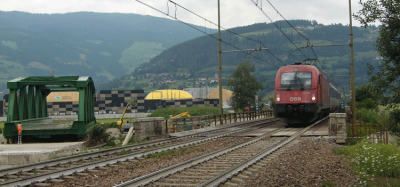Detection of wheel-rail contact conditions for improved train control
Posted: 6 February 2012 | | No comments yet
The contact between wheels and track is fundamental to railway operations, but the contact conditions are affected by often unpredictable external sources of contamination such as fallen tree leaves, snow and rain which can substantially reduce the level of adhesion of the track that is essential to the delivery of tractive effort for traction and braking systems in railway vehicles. The problem of low adhesion reduces the traction and causes wheel spin when trains accelerate or lock their wheels to slow down which can potentially cause severe wear of wheel and rail surfaces, increase mechanical stress in the system and affect stability.
The history of adhesion management can be traced back to the use of sanding systems in locomotives to improve adhesion as early as the late 19th century, but there have since been significant advances in wheel slip/slide protection (WSP) technologies for braking and traction systems. The most commonly used wheel slip protection schemes are achieved by measuring and controlling the slip ratio (relative speed between a wheel and the train) and in more extreme cases to control the wheel rotational acceleration below a pre-defined threshold. Further performance enhancement may be obtained with the use of hybrid anti-slip approaches with the use of slip, wheel speed and acceleration information. Those controllers are difficult to obtain optimal performance and also require accurate measurement of wheel slip. In general, WSPs are effectively reactive systems, i.e. only ‘activated’ to stop wheel slip/slide when detected by the sensors.
The contact between wheels and track is fundamental to railway operations, but the contact conditions are affected by often unpredictable external sources of contamination such as fallen tree leaves, snow and rain which can substantially reduce the level of adhesion of the track that is essential to the delivery of tractive effort for traction and braking systems in railway vehicles. The problem of low adhesion reduces the traction and causes wheel spin when trains accelerate or lock their wheels to slow down which can potentially cause severe wear of wheel and rail surfaces, increase mechanical stress in the system and affect stability. The history of adhesion management can be traced back to the use of sanding systems in locomotives to improve adhesion as early as the late 19th century, but there have since been significant advances in wheel slip/slide protection (WSP) technologies for braking and traction systems. The most commonly used wheel slip protection schemes are achieved by measuring and controlling the slip ratio (relative speed between a wheel and the train) and in more extreme cases to control the wheel rotational acceleration below a pre-defined threshold. Further performance enhancement may be obtained with the use of hybrid anti-slip approaches with the use of slip, wheel speed and acceleration information. Those controllers are difficult to obtain optimal performance and also require accurate measurement of wheel slip. In general, WSPs are effectively reactive systems, i.e. only ‘activated’ to stop wheel slip/slide when detected by the sensors.
The contact between wheels and track is fundamental to railway operations, but the contact conditions are affected by often unpredictable external sources of contamination such as fallen tree leaves, snow and rain which can substantially reduce the level of adhesion of the track that is essential to the delivery of tractive effort for traction and braking systems in railway vehicles. The problem of low adhesion reduces the traction and causes wheel spin when trains accelerate or lock their wheels to slow down which can potentially cause severe wear of wheel and rail surfaces, increase mechanical stress in the system and affect stability.
The history of adhesion management can be traced back to the use of sanding systems in locomotives to improve adhesion as early as the late 19th century, but there have since been significant advances in wheel slip/slide protection (WSP) technologies for braking and traction systems. The most commonly used wheel slip protection schemes are achieved by measuring and controlling the slip ratio (relative speed between a wheel and the train) and in more extreme cases to control the wheel rotational acceleration below a pre-defined threshold. Further performance enhancement may be obtained with the use of hybrid anti-slip approaches with the use of slip, wheel speed and acceleration information. Those controllers are difficult to obtain optimal performance and also require accurate measurement of wheel slip. In general, WSPs are effectively reactive systems, i.e. only ‘activated’ to stop wheel slip/slide when detected by the sensors.
In some rail networks, LAWS (Low Adhesion Warning System) or AMS (Adhesion Management Systems) are used to provide estimates of track conditions based on a large pool of track side measurements such as site topography, track geometry, microclimates and contaminations etc. It is widely recognised that such localised adhesion conditions can be very beneficial to the train drivers and to the network operators as they can take preventative measures and plan the train journeys and train schedules accordingly to maximise the network capacity and efficiency within the constraint of the track conditions. Such systems are inevitably very complex, expensive to implement and potentially difficult to deliver reliable estimates because of the large number of sensors to be installed across a network and the amount of data to be collected and processed. A research team led by Professor T X Mei (Director of CASE Control and Systems Engineering Research Centre at the University of Salford, UK) has now developed a novel approach to monitor the adhesion conditions in real time using simple and low cost sensors mounted on commercial trains.
Vehicle Based Adhesion Detection
There are two main issues that make the monitoring of the wheel-rail contact conditions extremely difficult. One is that the adhesion forces have nonlinear features in relation to the relative motion of the two surfaces at the wheelrail contact point(s) known as creep or creepages as illustrated below.
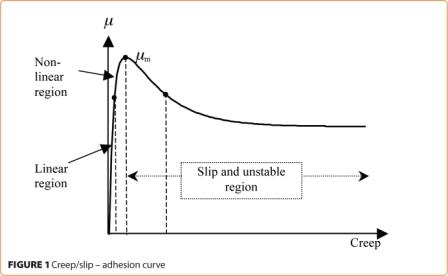

Creep/slip - adhesion curve
The second problem is that this non-linear relation is not fixed and can vary substantially and quickly from one section of the track to another, influenced by a wide range of factors and parameters. In poor contact conditions, the maximum adhesion (μm) available can be far below what is needed for the normal provision of traction or braking.
The solution proposed by the Salford team exploits the fact that the dynamic behaviour of a railway vehicle is also strongly affected by the nonlinearity as well as the variations in the creep characteristics. For example, in normal running conditions where the creep is small, the contact forces provide a damping effort to the dynamic modes of wheelsets/bogies and are very useful in stabilising those modes which would otherwise be almost critically damped (e.g. with material damping only). As the creep increases, the contact forces can operate in the second (or non-linear) region where the rate of change of the creep forces and associated damping effect is much lower. However, when the creep is beyond the point of maximum adhesion (μm) available at the wheel-rail interface and enters the slip or unstable region, the contact forces will then become a destabilising element, which not only cause the well known problem of wheel slip (in traction) or slide (in braking) but also can cause other undesirable mechanical instabilities in the bogies.
It is this link between the vehicle dynamics and contact conditions that forms the basis of the new approach for adhesion estimation. The principle of the proposed detection scheme is shown below.
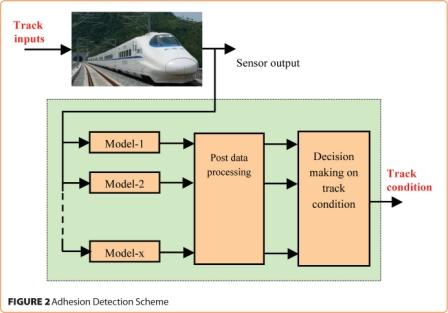

Adhesion Detection Scheme
The technology developed by the Salford team involves the use of a number of carefully selected mathematical models (or estimators) of a rail vehicle to mimic train dynamic behaviours in response to different track conditions. Each of the estimators is tuned to match one particular track condition to give the best results at the specific design point. Increased estimation errors are expected if the contact condition is not at or near the chosen operating point. The level of matches/ mismatches is reflected in the estimation errors (or residuals) of the models concerned, when compared with the real vehicle (through the measurement output of vehicle mounted inertial sensors) – as it is clearly demonstrated here using results from computer simulations where the model 1 is tuned for and expectedly provides much smaller estimation errors at the operation condition.
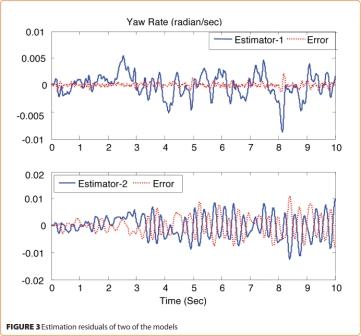

Estimation residuals of two of the models
The output residuals from all the models are then assessed using an artificial intelligence decision making approach to determine which of the models provide a best match to the present operating condition and hence to give real time information about the track conditions.
A fuzzy reasoning procedure is developed to translate and map the estimation residuals from all the models into direct information of track conditions and adhesion levels that can be used by train drivers and network operators (or traction/braking control systems). What to expect from the decision making process can be seen below. There are two outputs – one indicates the maximal adhesion available and the other shows the actual operation conditions, e.g. a traction or braking system is operating near the level of saturation for the available adhesion. Repeated tests in a variety of contact conditions using computer simulations have shown excellent consistency and robustness of the novel detection method.
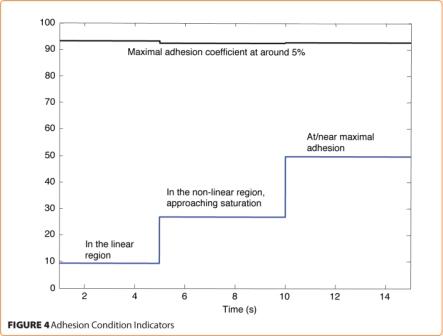

Adhesion condition indicators
Summary
The problem of low adhesion and its adverse impact on train control systems and rail network operations present a significant technological challenge to the railway industry, but on the other hand provide a great research opportunity for the academic community. It is clear that alternative methods are possible and can be achieved through research and innovations. The adhesion detection method presented in this article lays a scientific foundation for a new way forward, although further work, e.g. track testing and experimental validation, will be needed before it can be put into practice – it can be commercially successful only if there is a greater collaboration and joint effort from the industrialists and the academic researchers.
The reward for the success can be potentially huge for the rail industry, as the information obtained from such systems can not only be used by the drivers to determine the maximum acceleration or braking forces they can apply, but also by rail network operators to optimise the train schedules and make the time tabling adaptive to track conditions in real time. The result is that the phenomenon of wheel slip/slide and associated damages and repair costs will be a thing of past. It also saves time because trains can be driven more efficiently in the speeds with the maximum use of adhesion available rather than using the current guidelines.
If you would like more detailed information or are interested in exploring collaboration possibilities to develop the system further, please contact the author by emailing him at [email protected].
About the author
Professor T.X. Mei took up the position of Chair in Control and Mechatronics at the School of Computing, Science and Engineering, Salford University, UK in 2009, having worked as an academic at the University of Leeds and industry for many years. Professor Mei has spent most of professional/academic career in the field of railway engineering and is a leading expert in a range of rail related subjects including vehicle dynamics and control, condition monitoring, fault tolerant train scheduling, intelligent sensing and data fusion, wheel-rail contact mechanics and traction control. Professor Mei’s educational background includes BSc (1982) in Railway Signalling, MSc (1985) in Condition Monitoring, MSc (1991) in Electrical Machines and PhD (1994) in Control Engineering.





